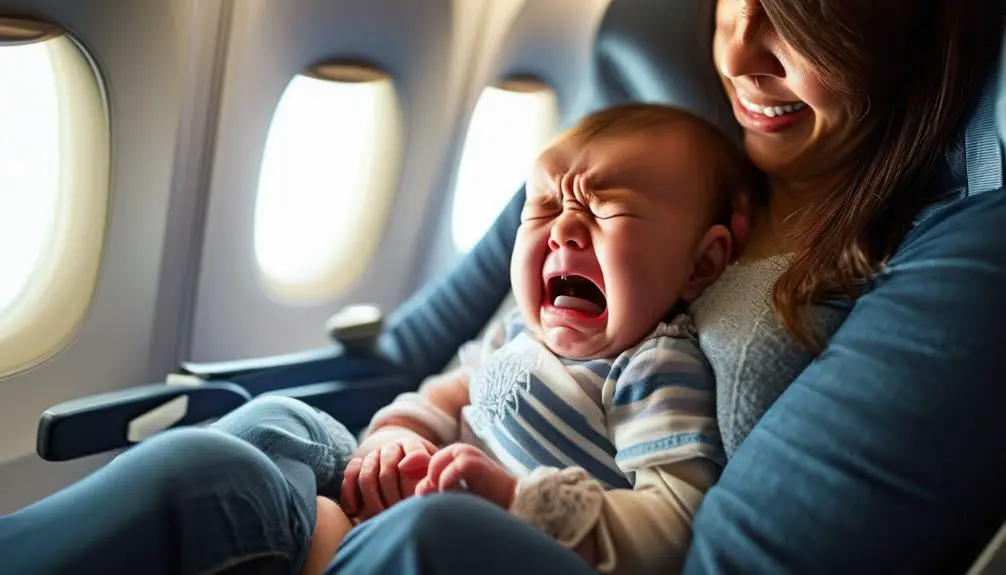When your baby cries on a plane, try these tips to bring comfort: use familiar items, cuddle them close and sway gently, and create a soothing atmosphere. Timing feedings wisely, using noise-canceling headphones, and having essentials on hand can help. Rock them softly, play white noise, and offer engaging toys for distraction. Reassure them with your touch and voice, and choose a seat wisely for a peaceful journey. Remember, other support options like seeking professional advice can also ease your worries. Ease the way for a smoother travel experience with these techniques.
Table of Contents
- Key Takeaways
- Comforting Familiarity
- Strategic Feeding
- Gentle Rocking Motion
- White Noise Utilization
- Distraction With Toys
- Temperature Regulation
- Calming Techniques
- Parental Reassurance
- Considerate Seating Arrangement
- Seeking Professional Help
- Frequently Asked Questions
- Can I Use a Pacifier to Help Calm My Crying Baby on a Plane?
- Is It Safe to Use Essential Oils for Relaxation During the Flight?
- How Do I Handle a Baby Who Is Teething and in Discomfort?
- What Should I Do if My Baby Is Sensitive to Changes in Air Pressure?
- Are There Any Specific Techniques for Calming a Colicky Baby During a Flight?
- Conclusion
Key Takeaways
- Implement familiar comfort items like a favorite blanket or toy to provide a sense of security.
- Hold your baby close and gently sway to mimic the soothing sensation of being held.
- Use white noise to create a calming environment that mimics sounds heard in the womb.
- Choose a seat near the engine for noise reduction and sit close to calm passengers.
- Engage in interactive play with sensory stimulation to distract and comfort your baby.
Comforting Familiarity
Wondering how you can provide comforting familiarity to calm a crying baby on a plane?
When a little one is upset in the air, offering familiar comfort and a soothing presence can work wonders. Babies often find solace in routines, so creating a comforting routine mid-flight can be incredibly helpful.
Try to mimic elements of their familiar environment, like using their favorite blanket or playing their go-to lullaby. Your familiar touch can reassure them amidst the unfamiliarity of flying.
Holding them close and gently swaying can provide the comfort they need. Remember, your calming presence and the familiarity you bring can make all the difference in soothing a crying baby during a flight.
Strategic Feeding

When it comes to calming a crying baby on a plane, strategic feeding can be your best ally.
Create a calm feeding environment by reducing distractions and noise around you.
Calm Feeding Environment
Creating a calm feeding environment can greatly help soothe your baby during a flight. Consider using noise-canceling headphones to minimize the impact of loud sounds that may startle your little one during feeding times. These headphones can create a more serene atmosphere, allowing your baby to focus on feeding peacefully.
Additionally, a portable breastfeeding pillow can provide a comfortable and supportive surface for both you and your baby, making feeding sessions more relaxed and enjoyable. By creating a soothing environment with the help of noise-canceling headphones and a portable breastfeeding pillow, you can enhance the feeding experience for your baby on a plane, helping to keep them content and calm throughout the journey.
Timing Is Crucial
To guarantee your baby stays calm and content during the flight, strategically timing their feeding sessions can make a significant difference in their comfort and mood. Consider aligning their feeding times with their sleep schedule to create a soothing routine. This can help them feel more relaxed and inclined to rest during the flight.
Additionally, make sure you have their comfort items readily available, such as a favorite blanket or toy, to provide familiarity and security. By being mindful of the timing of feedings and incorporating comforting elements, you can help create a peaceful environment for your baby on the plane.
Proper Feeding Position
Positioning your baby correctly while feeding can play an important role in ensuring their comfort and minimizing potential discomfort during the flight.
When bottle-feeding, maintain a proper bottle angle to prevent air intake, reducing the chances of gas discomfort.
For breastfeeding, finding a comfortable and secure position can help establish a proper latch, ensuring efficient feeding and reducing air ingestion. Remember to burp your baby frequently during feeding breaks to release any trapped air that could cause discomfort.
Experiment with different positions to find what works best for you and your baby.
Gentle Rocking Motion
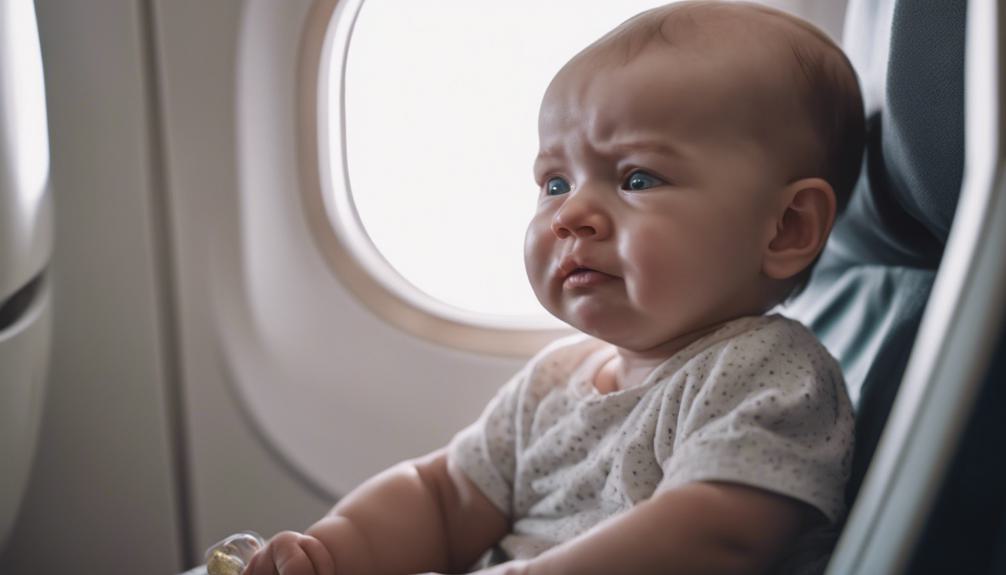
When soothing a crying baby on a plane, gently rocking them in your arms can help calm them down and provide comfort. The gentle bouncing motion combined with soothing music or a rhythmic swaying movement while playing a lullaby playlist can create a calming environment for the baby.
The feeling of being securely held and the familiarity of the music can work wonders in soothing a distressed little one. Rocking back and forth can mimic the comforting sensation of being in the womb, helping the baby relax and feel safe.
White Noise Utilization
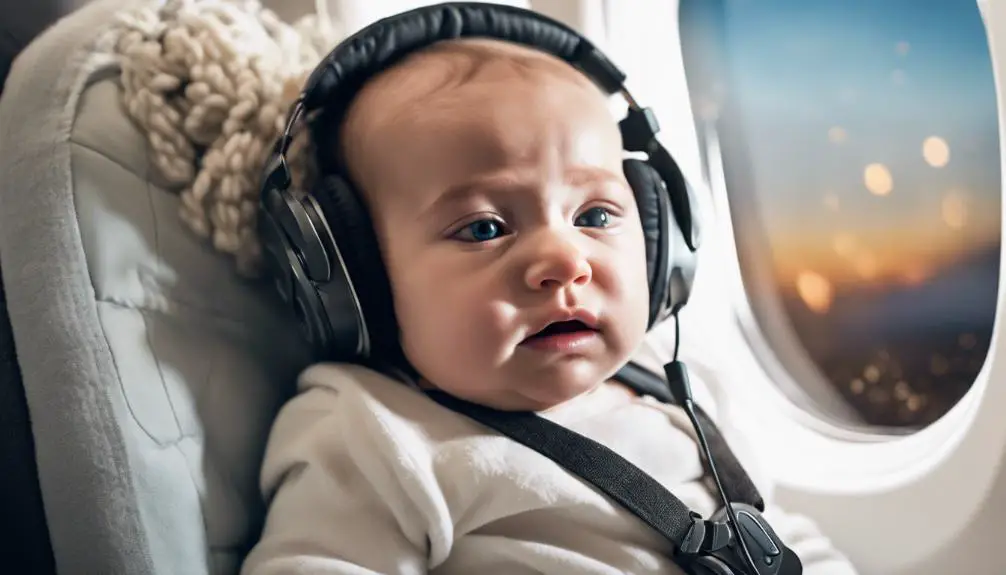
Utilize white noise to help soothe a crying baby on a plane by creating a consistent and calming background sound that can drown out potentially disruptive noises during the flight. White noise offers numerous benefits for babies, as it can mimic the sounds they heard in the womb, providing a sense of comfort and security.
When choosing a sound machine, opt for one with adjustable volume levels and various sound options like gentle rain, ocean waves, or soft lullabies. These machines are portable and can easily be packed in your carry-on. The rhythmic sounds can help lull your baby into a peaceful sleep, making the journey more pleasant for both you and your little one.
Distraction With Toys
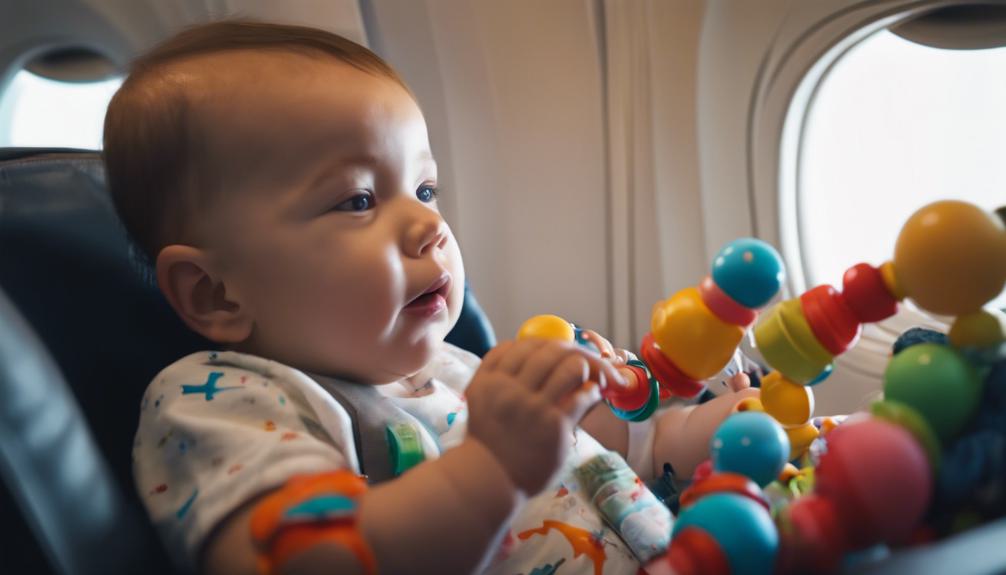
When it comes to calming a crying baby on a plane, choosing the right toys can make all the difference.
You’ll want to select toys that are engaging and enthralling for your little one. Interactive play ideas and age-appropriate distractions can help keep your baby entertained and content during the flight.
Toy Selection Tips
Wondering which toys are best for calming a crying baby on a plane? When selecting toys, consider toy rotation to keep things engaging. Opt for toys that provide sensory stimulation, such as soft textures or gentle sounds. Comfort items like a security blanket can offer familiarity and a sense of safety during the flight.
Babies often find solace in items that remind them of home. Remember to pack a few different options to switch between if your little one gets restless. By offering a variety of toys that cater to different senses and emotions, you can help create a soothing environment for your baby on the plane.
Interactive Play Ideas
To keep your baby entertained and calm during a plane journey, engage in interactive play with toys that stimulate their senses and encourage exploration. Sensory stimulation is key to keeping your little one engaged. Opt for toys with different textures, colors, and sounds to capture their interest.
Rattles, soft plush toys, or toys that make gentle noises can provide both entertainment and comfort during the flight. Bonding activities such as peek-a-boo or singing nursery rhymes while playing with toys can create a sense of security and closeness, helping to ease any anxiety your baby may feel.
Age-Appropriate Distractions
For a more peaceful flight experience with your little one, consider using age-appropriate toys as distractions. Sensory stimulation plays an essential role in keeping babies engaged and content during travel. Opt for toys that offer various textures, sounds, and colors to captivate their attention.
Toys that align with your baby’s developmental milestones can also be beneficial. For example, choose toys that encourage fine motor skill development or cognitive growth. Interactive toys like soft books, rattles, or stacking rings can provide entertainment while promoting learning.
Temperature Regulation
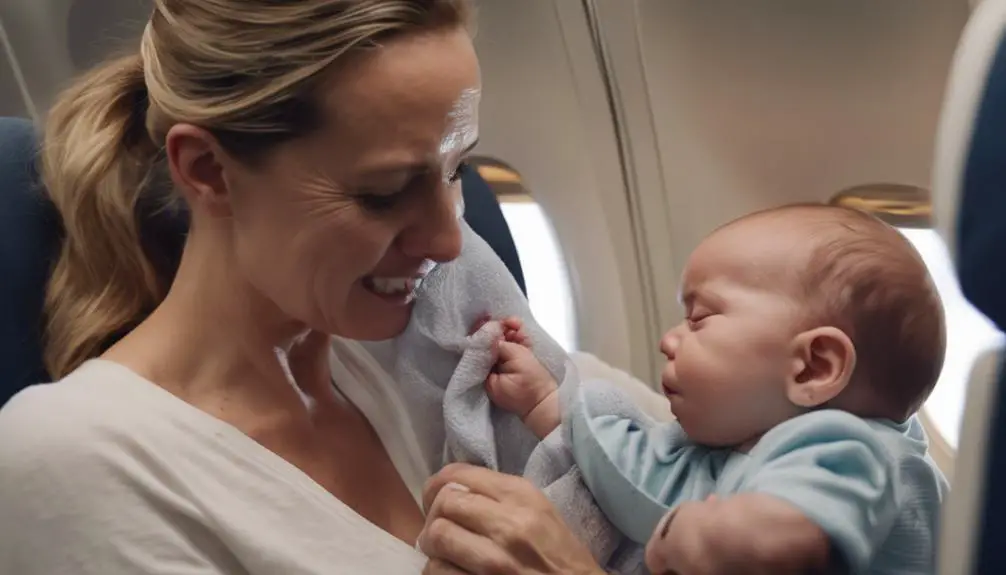
Feeling too warm or too cold can often trigger crying in babies on a plane, making it important to regulate the temperature around them effectively. To help regulate your baby’s body temperature, dress them in layers so you can adjust as needed.
Consider bringing a light blanket in case it gets chilly during the flight. Maintaining a comfortable temperature can also aid in regulating their sleep patterns, promoting rest when needed.
Be mindful of drafts from air vents and try to shield your baby from direct airflow. Remember, babies can’t communicate their discomfort like adults, so paying attention to their temperature needs can help prevent unnecessary fussiness during the flight.
Calming Techniques
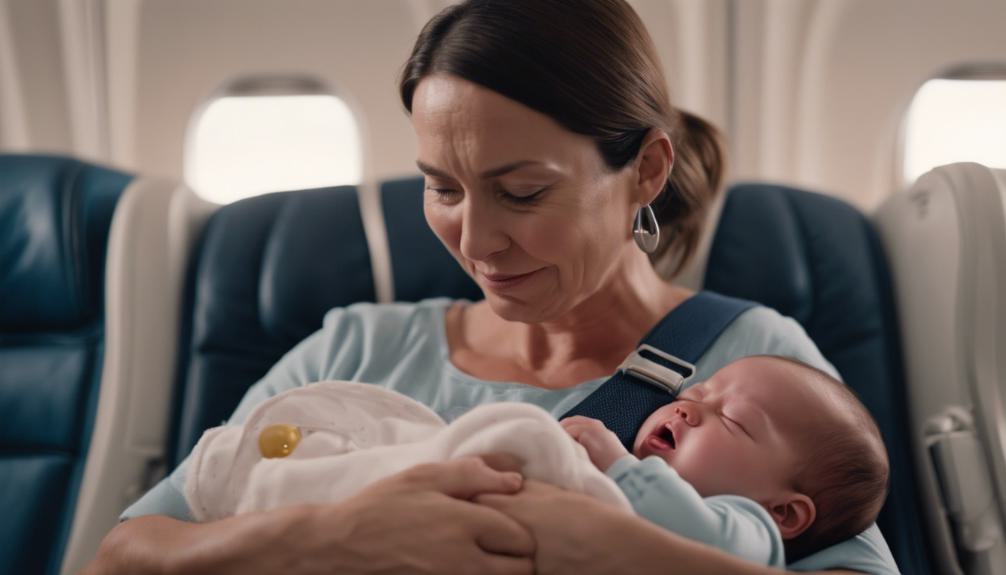
When soothing a crying baby on a plane, try gently rocking them in your arms while speaking softly to provide comfort and reassurance. This physical contact can help soothe the baby and make them feel secure.
Additionally, consider utilizing babywearing benefits by using a carrier or wrap to keep your baby close to you. The motion of walking up and down the aisle while wearing your baby can have a significant effect.
Playing soothing music through headphones for both you and the baby can also create a relaxing atmosphere. Remember, staying calm and composed yourself is vital as babies can pick up on your emotions.
Parental Reassurance

During moments of distress, calmly holding your baby close and speaking softly can provide the reassurance they need to feel safe and secure. Parental bonding is vital in such situations.
Your soothing touch, combined with a gentle tone of voice, communicates love and security to your little one, helping them calm down. This connection between parent and child is a powerful tool in comforting a crying baby on a plane.
Remember, your presence alone can work wonders in reassuring your baby amidst the unfamiliar sounds and sensations of air travel. Embrace this opportunity to strengthen your bond and offer the comfort your baby seeks in your arms.
Trust your instincts and let your parental love guide you through this challenging moment.
Considerate Seating Arrangement
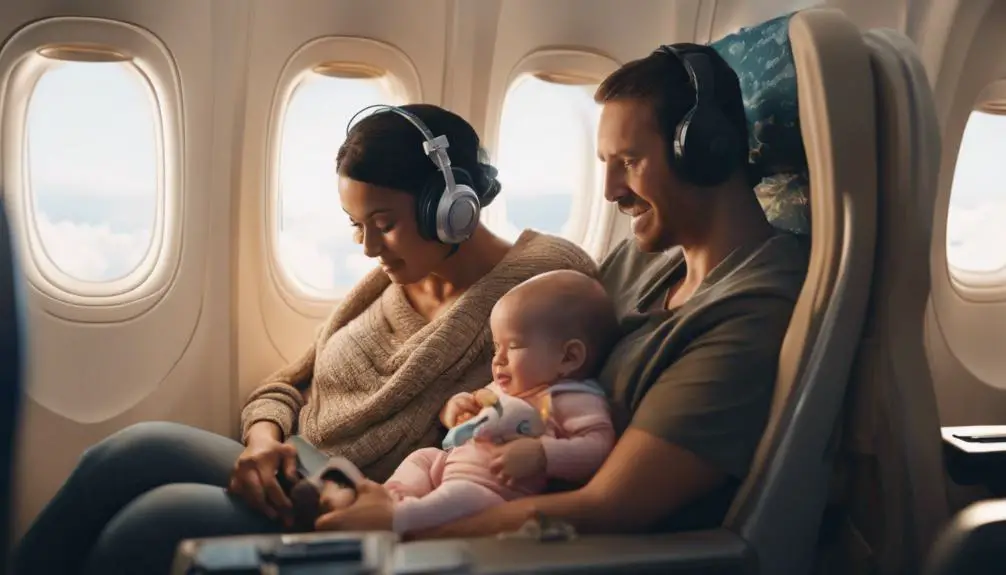
When choosing your seat on a plane with a crying baby, consider sitting near the engine where the noise can help drown out the sound.
Opt for a spot close to passengers who seem calm and understanding, as their presence can make a difference in how the situation unfolds.
Being mindful of your seating arrangement can help create a more peaceful environment for everyone on the flight.
Seat Near Engine
Consider selecting a seat near the engine when flying with a crying baby to help minimize the noise disturbance for fellow passengers. Sitting closer to the engine can help drown out some of the baby’s cries with the consistent hum of the engine. Additionally, the engine vibrations may have a soothing effect on the baby, helping them calm down and potentially fall asleep during the flight.
For other passengers, noise-canceling headphones can also be a great help in reducing any unwanted disturbances. Being mindful of where you sit can make a significant difference in the overall comfort of everyone on the plane and contribute to a more pleasant flight experience for all.
Near Calm Passengers
To enhance the comfort of both your baby and fellow passengers, strategically choosing a seat near calm passengers can help create a considerate seating arrangement conducive to a more peaceful flight environment. Sitting close to individuals who exude a sense of tranquility can have a soothing effect on your baby and may even help you feel more at ease.
Consider passengers who are using noise-canceling headphones or practicing relaxation techniques; their calming presence can positively influence the overall atmosphere. Observing stress management strategies from nearby passengers can also provide you with additional tools to manage any challenging moments during the flight.
Seeking Professional Help

If you find yourself overwhelmed and unsure about how to calm your crying baby on a plane, reaching out to a pediatrician or a child psychologist can provide valuable guidance and support. These professionals can offer insights on therapy options, support groups, counseling services, and mental health resources that may help both you and your baby cope better with the situation.
Pediatricians can assess if there are any underlying medical issues contributing to your baby’s distress, while child psychologists can provide strategies to manage the stress and anxiety associated with flying. Remember, seeking professional help is a proactive step towards ensuring the well-being of both you and your little one during air travel.
Frequently Asked Questions
Can I Use a Pacifier to Help Calm My Crying Baby on a Plane?
You can use a pacifier to help calm your crying baby on a plane. It’s a safe and effective soothing method. However, if the baby doesn’t respond well, try alternative methods like gentle rocking or feeding.
Is It Safe to Use Essential Oils for Relaxation During the Flight?
Yes, it’s safe to use essential oils for relaxation on a plane. Aromatherapy safety is important, so choose calming scents like lavender or chamomile. Essential oil alternatives like a soothing rollerball can help you relax during the flight.
How Do I Handle a Baby Who Is Teething and in Discomfort?
When handling a teething baby in discomfort, try teething remedies like cold teething toys or a chilled washcloth. Offer distractions with colorful toys or gentle music. Comfort measures such as cuddling, rocking, and soothing techniques can help ease their pain.
What Should I Do if My Baby Is Sensitive to Changes in Air Pressure?
When your baby is sensitive to air pressure changes, consider using ear protection like specialized earplugs or gently comforting them to alleviate discomfort. Be proactive in addressing their needs to guarantee a smoother journey.
Are There Any Specific Techniques for Calming a Colicky Baby During a Flight?
When flying with a colicky baby, try infant massage and using white noise to soothe them. Gently massage their tummy or back to ease discomfort, and white noise can help drown out the loud plane sounds, creating a calming environment.
Conclusion
To sum up, when dealing with a crying baby on a plane, remember to stay calm and patient. By using these top tips, you can help soothe your little one and make the journey more enjoyable for everyone on board.
Remember, Rome wasn’t built in a day, so don’t expect instant results. Just keep trying different techniques and eventually, you’ll find what works best for your baby.
Safe travels!

